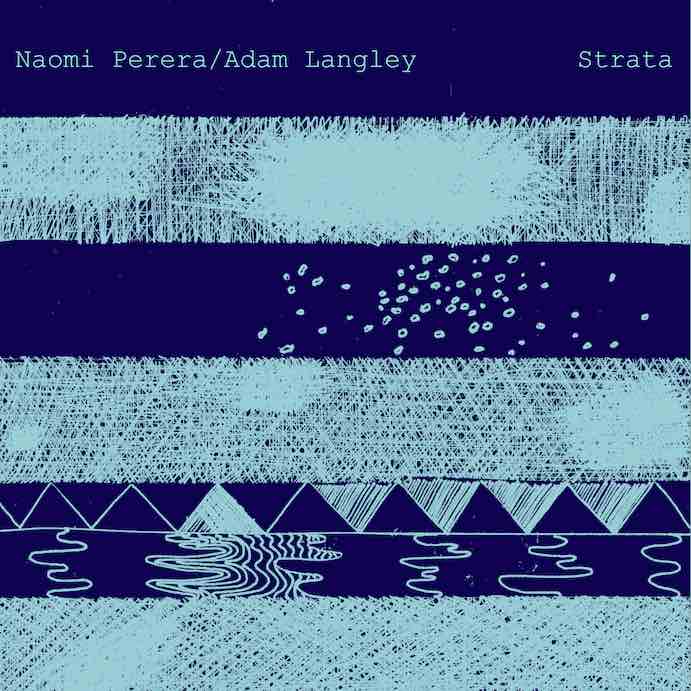When most musicians talk about “playing” music, what they mean is “performing.” But for improvisers and experimentalists from Yoko Ono to John Zorn, “playing” music can be a game, where instructions and prescriptions are traded for whimsy, precarity, and dynamism. It’s with exactly this sentiment that Naomi Perera and Adam Langley approached Strata, an EP that is part-improvisation, part-recreation.
Although the UK-based duo of electronics and flute was founded to bring live, in-person improvisations to their audiences, the nation’s strict lockdowns in the wake of Covid necessitated a different approach. Each of Strata’s five tracks began as a digitally-mediated volley: Langley (electronics) and Perera (flute) traded takes back and forth, overdubbing one another’s live improvisations and effects in call and response. Grouping individual sounds into layers, the duo created composites that are focused with laserlike intensity.
If their methodology seems tinged with practices more at home in painting or writing, it’s no coincidence. Their formula was inspired by the surrealists’ exquisite corpse games of the 1920s and 30s, where artists like André Breton and Frida Kahlo composed stories in a word-by-word round robin, or took turns adding new elements to drawings. For Perera and Langley, each new take of a track was a chance for simulated musical interaction, to give an authentic response to their partner’s contributions, albeit asynchronously.
The numeric track titles reflect the improvisation’s original length in minutes in the first digit, and the number of layers in the second digit. Opening with “Stratum 66” (six minutes, six layers), the listener is dropped into an expansive mix replete with wind sounds in both flute and electronics, but Perera’s switch to sustained tones quickly grounds the listener as the competing textures proliferate. Her wending melodies are the track’s focal point, subtly shaded by the bass flute’s fidgety ostinato and electronically-manipulated drones. Pitch is alluringly unstable. Deft microtonal manipulations and breathy bends away from center place Perera at times squarely within the overtones of Langley’s dense drones; at others, their juxtaposition adds brief jabs of friction. Where the track begins by foregrounding ruminative, improvisatory flute, its end is forceful and aggressive, pitting each track of electronics against the others in a bid for dominance.

Adam Langley and Naomi Perera–Photo courtesy of the artists
“Stratum 78” steadily builds tension, even as the duo trades roles. The first section is driven by Perera’s distant whistle tones, contrasted with timbral trills mixed much closer to the listener. In the next section, Langley foregrounds a rhythmicized crackle. With a combination of delay and decreasing the time to each new articulation, the crackle transitions to a staticky texture. Over this, Perera reprises her whistle tones and bisbigliando, building to a climax of dense electronics and upper-register long tones and timbral trills before abruptly fading out.
The album’s remaining tracks are miniatures of three minutes or less, outlining soundworlds or atmospheres rather than narratives. The duo’s program notes for “Stratum 46” describe its conception during a time of deep grief. Listeners can feel it viscerally: strident long tones in the flute are propelled by the blare of grinding, mechanistic noise walls interspersed with strained gasps. The album’s closer, “Stratum 24,” is comparatively mild. Echoing her melodies from “Stratum 66,” Perera’s layers are markedly more in the foreground, with Langley’s wash of synthesized rain and drones buzzing just under the surface. While this track (like the album at large) is never sparse, per se, the duo’s intentional use of fewer layers allows more audible space, an element that is difficult to capture as the layers pile up.
One of the most fascinating things about the album’s processual creation is the tracks that bear the traces of aural red pen. In “Stratum 66,” the soundworld of the beginning is stricken-through, negated: from the middle of the track, Langley’s layers embark on a wholesale reconstruction. Whooshing wind sounds are painted over by electronified bird calls and motoric synth. While Perera’s gentle melodies remain constant, Langley’s electronics migrate to an atmosphere of jarring timbres in consonant harmonies. But the tension between the track’s beginning and end is a productive one, more recontextualization than overwriting.
For the listener, Strata is a game of grouping. We might relate sounds by texture, timbre, melody, and mood, but the uncertainty and surprise inherent to improvisation means that no individual sound has a clear cut partner. Just as its surrealist precursors, Strata is a musical landscape teeming with activity—whether striking and vibrant, or lurking subtly at the edge of attention—and listeners have all the agency to choose which sounds to apprehend and engage—or not.
I CARE IF YOU LISTEN is an editorially-independent program of the American Composers Forum, funded with generous donor and institutional support. Opinions expressed are solely those of the author and may not represent the views of ICIYL or ACF.
A gift to ACF helps support the work of ICIYL. For more on ACF, visit the “At ACF” section or composersforum.org.






















